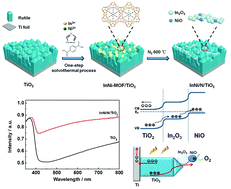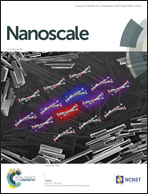Photoelectrochemical properties of MOF-induced surface-modified TiO2 photoelectrode†
Abstract
Heteroatom doping and surface modification with oxides are both important strategies to improve the photoelectrochemical (PEC) activities of TiO2 photoelectrodes. However, it is difficult to combine the two strategies into a single synthesis process. Herein, a simple one-pot synthesis method was developed to modify a TiO2 photoelectrode surface by N-doping while simultaneously modifying the surface with In2O3 and NiO. This method involved growing MOF onto a TiO2 surface with N-containing organic ligands and In and Ni salts as metal precursors, followed by heat treatment at 600 °C. The roles of heteroatom doping and oxide modification are proposed as follows. (i) N-Doping extends the absorption edge of the TiO2 to a longer wavelength region and enhances visible light absorption. (ii) N-Doping together with the passivation of TiO2 surface trap states by oxide modification increases the donor density in TiO2. (iii) The generated suitable interfaces on the surface of TiO2 facilitate photogenerated charge separation and transfer. In comparison with the pristine TiO2 photoelectrode, the metal oxide- and heteroatom-modified TiO2 photoelectrode exhibits superior photoelectrochemical performance under both simulated sunlight and visible light illumination. Suitable substrate of the electrode, appropriate size of the as-synthesized MOF precursors, and choice of ligands and metal ions are important factors for this strategy.



 Please wait while we load your content...
Please wait while we load your content...
